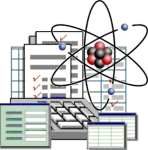2007-10-01 Presentation at the Second Internat. Conf., dedicated to the 150th Anniversary of A.M. Lyapunov "Nonlinear Dynamics – 2007", Kharkov, Ukraine, September 25-28, 2007 33 P. First lasing of Volume Free Electron Lasers (VFEL) in mm wavelength range was obtained recently [1]. So-called multiwave volume distributed feedback (VDFB) where electromagnetic waves and electron beam spread angularly one to other is the distinctive feature of VFEL. The principles and theoretical foundations of VFEL operation based on mechanism of VDFB were proposed in [2]. The main VFEL characteristic property is that the increment of instability for an electron beam passing through a spatially-periodic target in degeneration points essentially increased in comparison with single-wave system. This means the noticeable reduction of electron beam current density necessary for achievement the generation threshold for all wavelength ranges regardless the spontaneous radiation mechanism.
In VFEL operation the linear stage investigated in many papers (see [1]) quickly changes into the nonlinear one where most of the electron beam energy is transformed into electromagnetic radiation. A detailed numerical analysis of this stage is necessary for experiment design, optimal geometry determination and result processing. Mathematical model and numerical methods for VFEL nonlinear stage simulation were proposed [3], [4]. They are implemented in computer code VOLC [5]. Different VFEL geometries were investigated [3]-[6] numerically. All numerical results are in good agreement with analytical predictions. In electronic generators and amplifiers such as free electron lasers, backward wave tube, travelling wave tube etc. self-oscillations are due to interaction of electron beam and electromagnetic field under distributed feedback. Investigation of chaos in such devices is of great interest in modern physics. In VFEL chaotic dynamics is induced by such interaction too. Investigation of chaos in VFEL is important in the light of experimental development of VFEL in Research Institute for Nuclear Problems. As more than ten control parameters are in the system it is very complicated to investigate the full picture of possible chaotic behaviour in VFEL. We restricted ourselves to investigate here the chaotic behaviour in two-wave VFEL for Bragg geometry in amplifier and oscillator generation regimes. We considered some cases of possible root to chaos in VFEL for laser intensity with corresponding space portraits and attractors. Solution bifurcation points cor-responding to transitions between different regimes of generation are considered. Parametric maps with respect to electron beam current and (1) geometry parameter, (2) detuning from exact Cherenkov condition present complicated root to chaos with windows of periodicity. It is demonstrated that this root is carried out via period-doubling cascade, quasiperiodicity and intermittency. References 1.V.G. Baryshevsky, K.G. Batrakov et al., First lasing of a volume FEL (VFEL) at a wavelength range 4-6 mm. Nucl. Instr. and Meth. in Phys. Res., A483, 21-24, 2002. 2. V.G. Baryshevsky, I.D. Feranchuk, Parametric beam instability of relativistic charged particles in a crystal. Physics Let. A., 102, 141–144,1984. 3. K. Batrakov, S. Sytova, Nonstationary stage of quasi-Cherenkov beam instability in periodical structures. Mathematical modelling and analysis, 10, 1-8, 2005. 4. K. Batrakov, S. Sytova, Modelling of Volume Free Electron Lasers. Computational Mathematics and Mathematical Physics, 45, 666–676, 2005 5. K. Batrakov, S. Sytova, Mathematical modelling of multiwave Volume Free Electron Laser: basic principles and numerical experiments. Mathematical modelling and analysis, 11, 13–22, 2006. 6. K. Batrakov, S. Sytova, Dynamics of electron beam instabilities under conditions of multiwave distributed feedback. Nonlinear Phenomena in Complex Systems, 8, 359–365, 2005. |



